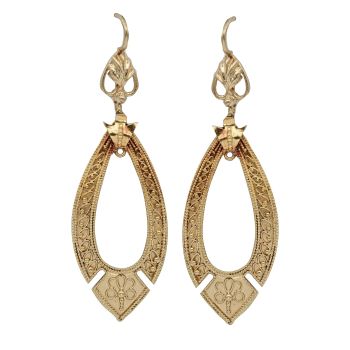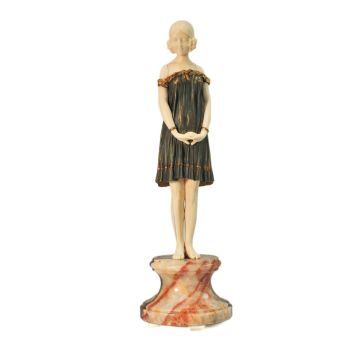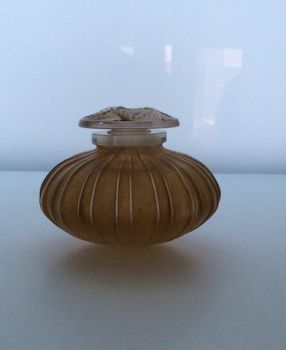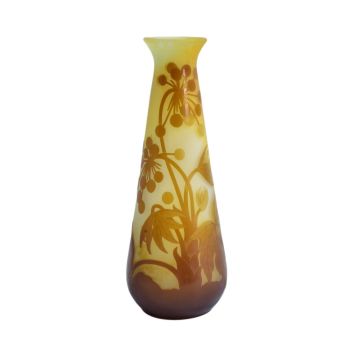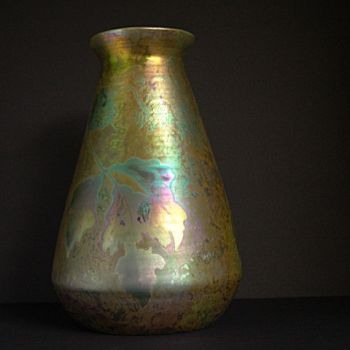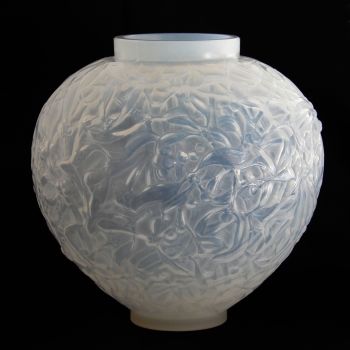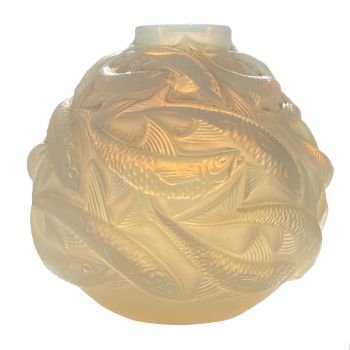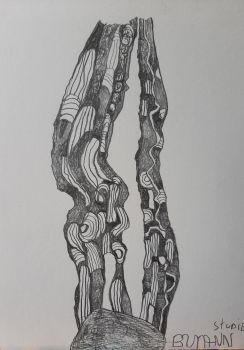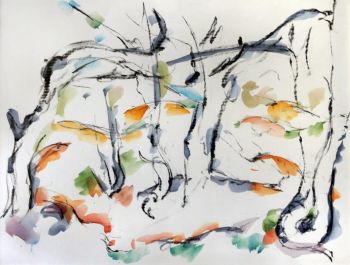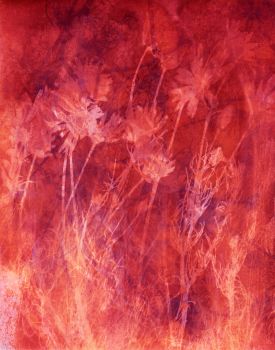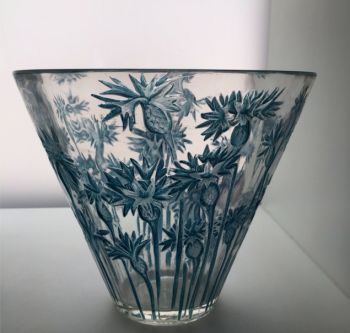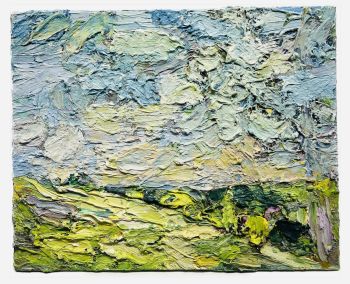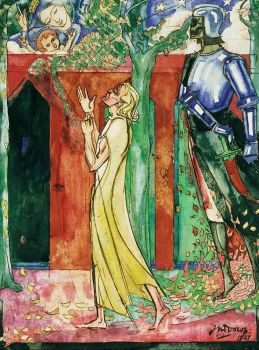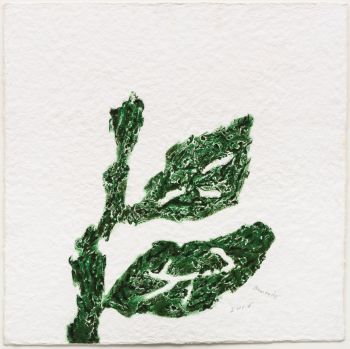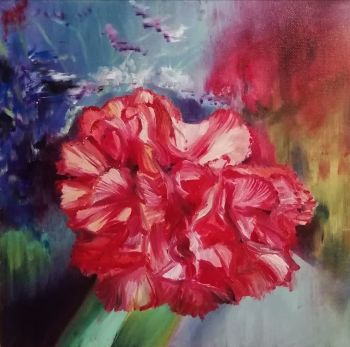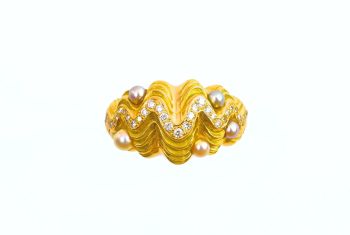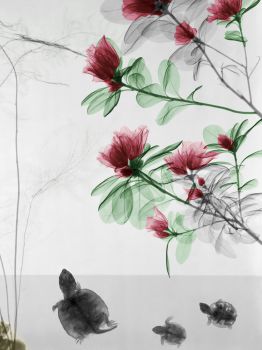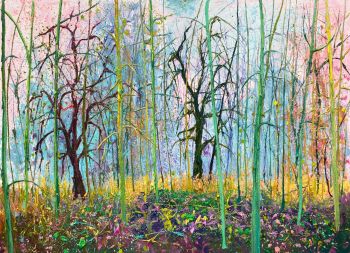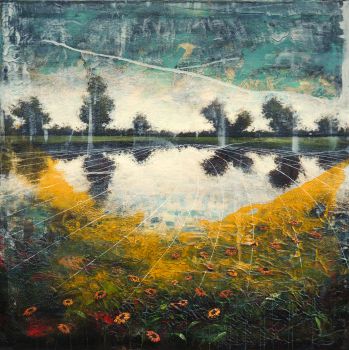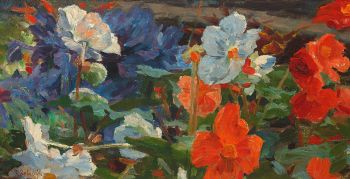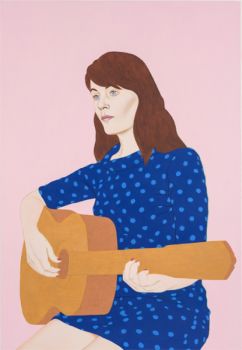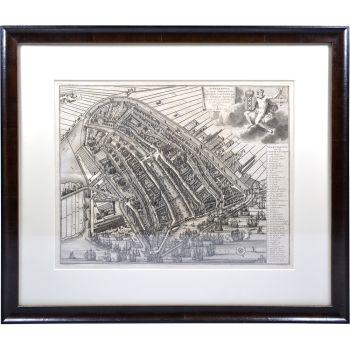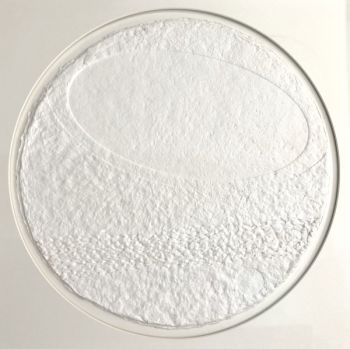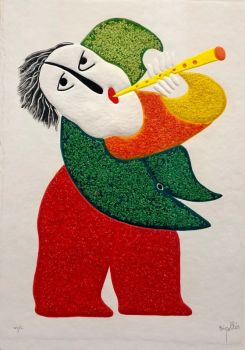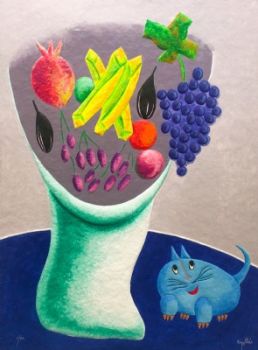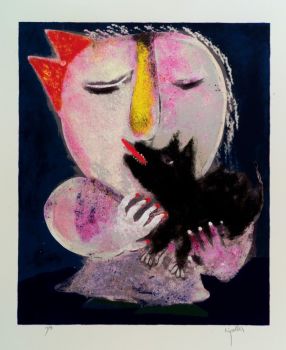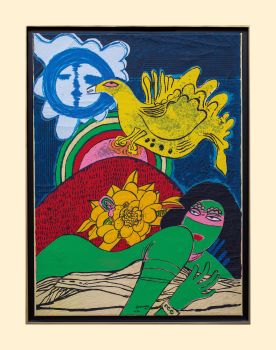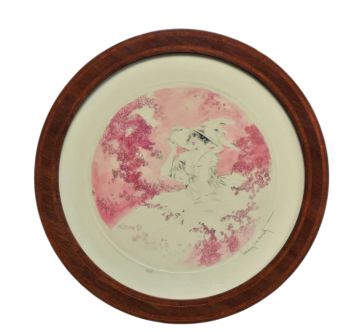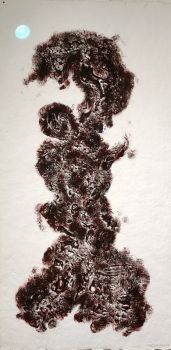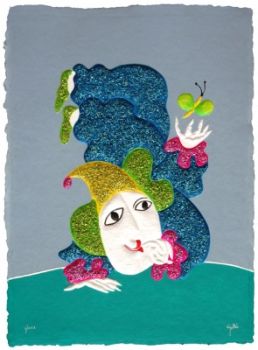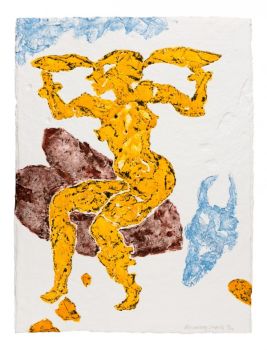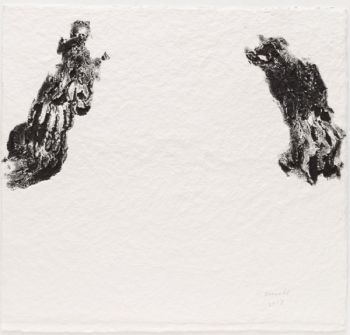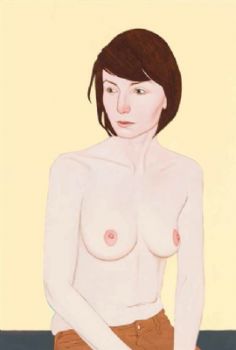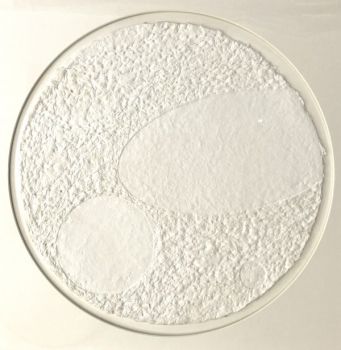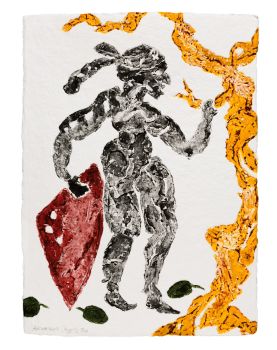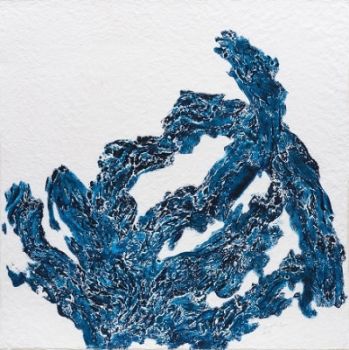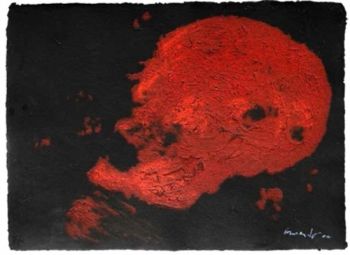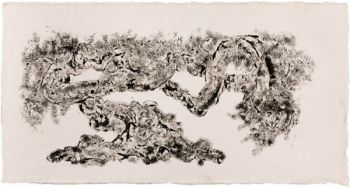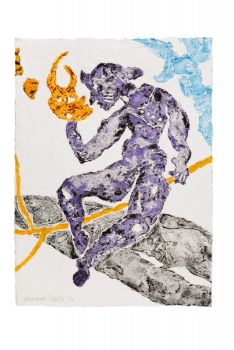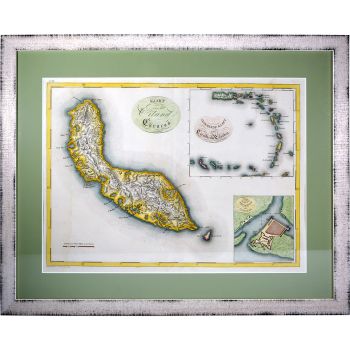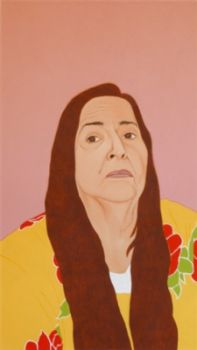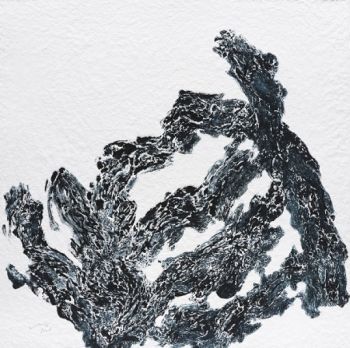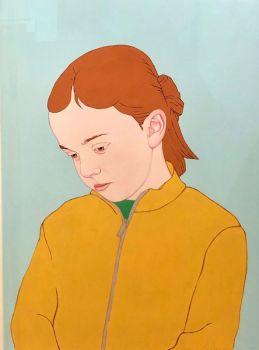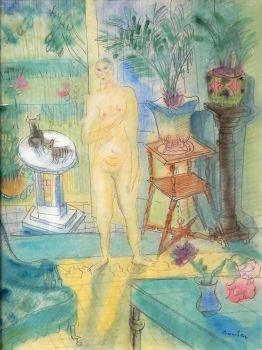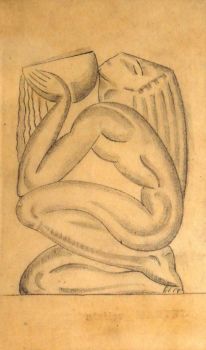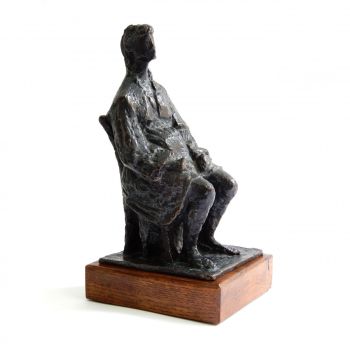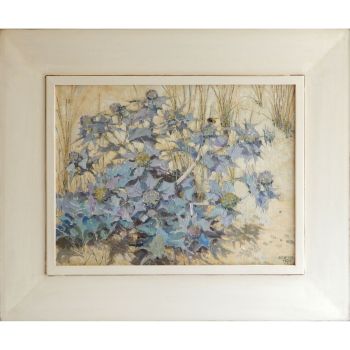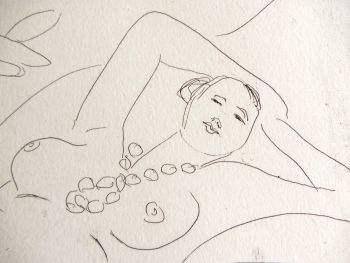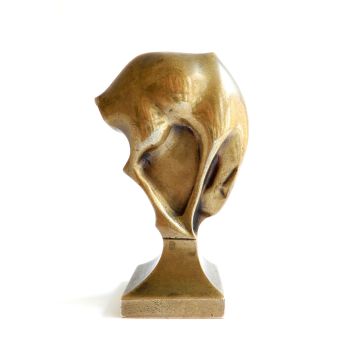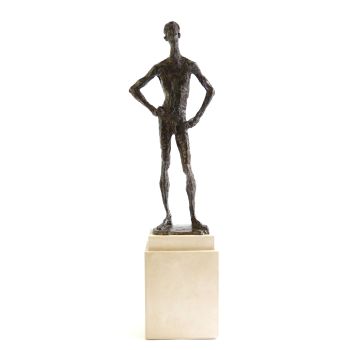Oval vase with a blossom branch 1875 - 1880
François Eugène Rousseau
ImpresiónGrabado
16 cm
ConditionNear mint
Precio a consultar
Dille Art
- Sobre la obra de arteRare vase by the French designer and creator François Eugène Rousseau (Paris, 1827-1891).
The vase has a very refined decoration inspired by Japanese art, a blossom branch of the quince with a butterfly.
The branch itself is cut in intaglio, the blossom and the butterfly are engraved and partly coloured.
The vase is oval in shape and made of smoky clear glass and double-layered (cased), at the top edge an application of blue glass has been warmly applied to the vase, giving the edge a dripping effect.
The quality of the vase is particularly high. From the middle of the 19th century, Rousseau was very much inspired by Japanese art, which, by opening Japan to foreigners, was just making its appearance in France.
The vase is signed on the bottom with "E. Rousseau Paris".
Biography:
François Eugène Rousseau (Paris, 1827-1891), his father owned a porcelain and ceramics shop on Rue Coqulliere in Paris. Rousseau went to work in his father's shop and also worked at the Manufacture de Sèvres, where he collaborated with several artists. In 1850 he took over the business from his father and also remained associated with the Manufacture de Sèvres. He was very interested in the introduction of Japanese art after the opening of Japan to foreign countries. He immersed himself in it more and decided to design a Japanese tableware with decorations by the painter/etcher Felix Bracquemond (1833-1914). The tableware was also exhibited at the Paris World's Fair of 1867, where it was a great success.
At the same time, he also set up a studio where he experimented with glass and glass decoration. Technically he was completely incompetent and he let his glass made by the brothers Adrien and Léon Appert in Clichy.
Rousseau has many ideas for special designs and decorations. The brothers like to carry it out, Rousseau takes care of the decorations himself, although he does have an assistant Eugène Michel who mainly does the engravings and intaglios.
Rousseau was inventive and original in his designs. His designs were often based on his interest in nature and Japan. Sometimes the shapes of his vases were very austere but applications were applied to them, sometimes his vases were completely free of shape and asymmetrical. He was one of the first French artists to experiment with cased, double-layered glass. He also made crackled glass which he filled in various colours and covered with clear, often coloured glass, creating special effects. Sometimes his glass seemed to be made of gemstone. But he also made double-layered smoky or clear glass vases with an engraved decor or with deeply carved decorations (intaglio technique) that were sometimes (partly) coloured or enamelled, often decorated with applications such as the vase above with a blue dripping effect, ears and/or masks in relief.
His vases were actually only made for special exhibitions, so in 1869 he sold two painted vases to the Albert & Victoria Museum. He also received many positive reactions to the Exposition de l'Union Centrale des Beaux-Arts appliqués à l'Industrie in 1874.
During this period, Ernest-Baptiste Léveillé also became his assistant and the glass cutter Alphonse-Georges Reyen also came to work for him. In 1885 he sold his business to Ernest Baptiste Léveillé, who continued to make the designs of his teacher and friend until 1890. The vases are signed from 1885-1890 with "E. Léveillé and E. Rousseau. After that Léveillé increasingly goes his own way.
François Eugène Rousseau died in 1891. Together with Emile Gallé, he is seen as the forerunner of modern glass art of this time.
Rousseau's vases are very rare and were only produced in small quantities for the major exhibitions, especially those in Paris. They were often purchased by the various museums that bought them for their permanent collections.
Literature:
- Philippe Olland; 'Dictionnaire des Maîtres Verriers de l'Art Nouveau á l'Art Déco Marques & signatures, p. 269-272, Éditions Faton 2016.
- Victor Arwas, 'Glass, Art Nouveau to Art Deco', p. 267-269, Academy Editions London, 1987.
Condition:
Good, the vase is in mint condition, no chips or polishing what so ever, just some colours of the coloured patina in the engraving are faded or washed away because of age and cleaning. - Sobre el artista
François Eugène Rousseau (París, 1827-1891), su padre era dueño de una tienda de porcelana y cerámica en la Rue Coqulliere de París. Rousseau fue a trabajar al taller de su padre y también trabajó en la Manufactura de Sèvres, donde colaboró con varios artistas. En 1850 se hizo cargo del negocio de su padre y también permaneció asociado a la Manufactura de Sèvres.
Estaba muy interesado en la introducción del arte japonés después de la apertura de Japón al extranjero. Se sumergió más en él y decidió diseñar una vajilla japonesa con decoraciones del pintor/grabador Felix Bracquemond (1833-1914). La vajilla también se exhibió en la Exposición Universal de París de 1867, donde obtuvo un gran éxito.
Al mismo tiempo, también montó un estudio donde experimentó con el vidrio y la decoración de vidrio. Técnicamente era completamente incompetente y dejó su copa hecha por los hermanos Adrien y Léon Appert en Clichy.
Rousseau tiene muchas ideas para diseños y decoraciones especiales. A los hermanos les gusta llevarlo a cabo, Rousseau se encarga él mismo de las decoraciones, aunque cuenta con un ayudante Eugène Michel que se encarga principalmente de los grabados y huecograbados.
Rousseau fue inventivo y original en sus diseños. Sus diseños a menudo se basaban en su interés por la naturaleza y Japón. A veces las formas de sus jarrones eran muy austeras pero se les aplicaban aplicaciones, a veces sus jarrones eran completamente libres de forma y asimétricos. Fue uno de los primeros artistas franceses en experimentar con vidrio de doble capa.
También hizo vidrio craquelado que rellenó en varios colores y cubrió con vidrio transparente, a menudo de colores, creando efectos especiales. A veces su copa parecía estar hecha de piedras preciosas. Pero también hizo jarrones de vidrio ahumado o transparente de doble capa con una decoración grabada o con decoraciones profundamente talladas (técnica de huecograbado) que a veces eran (parcialmente) coloreadas o esmaltadas, a menudo decoradas con aplicaciones como el jarrón de arriba con un efecto de goteo azul, orejas y/o caretas en relieve.
Sus jarrones en realidad solo se hicieron para exposiciones especiales, por lo que en 1869 vendió dos jarrones pintados al Museo Albert & Victoria. También recibió muchas reacciones positivas a la Exposition de l'Union Centrale des Beaux-Arts appliqués à l'Industrie en 1874.
Durante este período, Ernest-Baptiste Léveillé también se convirtió en su asistente y el cortador de vidrio Alphonse-Georges Reyen también pasó a trabajar para él. En 1885 vendió su negocio a Ernest Baptiste Léveillé, quien continuó haciendo los diseños de su maestro y amigo hasta 1890. Los jarrones están firmados entre 1885 y 1890 con "E. Léveillé y E. Rousseau". Después de eso, Léveillé se va cada vez más por su cuenta. camino.
François Eugène Rousseau murió en 1891. Junto con Emile Gallé, se le considera el precursor del arte moderno en vidrio de esta época.
Los jarrones de Rousseau son muy raros y solo se produjeron en pequeñas cantidades para las grandes exposiciones, especialmente las de París. A menudo fueron comprados por varios museos que los compraron para sus colecciones permanentes.
¿Está interesado en comprar esta obra de arte?
Artwork details
Related artworks
Artista Desconocido
François-Théodore Legras – Tall “Fleurs de Pommier” apple blossoms vase1900 - 1909
Precio a consultarAntiques Emporium
Johann Loetz (Lötz) Witwe Klostermühle
Johann Loetz Witwe – Ausfuehrung 146 Titania vase – 19121910 - 1919
Precio a consultarAntiques Emporium
1 - 4 / 24Frères Daum
Daum Nancy – “Paysage Soleil Couchant” vase with two applied handles1900 - 1910
Precio a consultarAntiques Emporium
Johann Loetz (Lötz) Witwe Klostermühle
Johann Loetz Witwe - Phänomen Genre 7773 – Orange1900 - 1910
Precio a consultarAntiques Emporium
Artista Desconocido
François-Théodore Legras – Tall “Fleurs de Pommier” apple blossoms vase1900 - 1909
Precio a consultarAntiques Emporium
1 - 4 / 24René Lalique
Un jarrón temprano 'Bluets' diseñado por Rene Lalique (1860-1945)1910 - 1920
Precio a consultarLennart Booij Fine Art and Rare Items
1 - 4 / 24- 1 - 4 / 24
- 1 - 4 / 12







